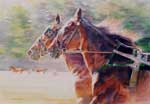The origins of the Standardbred trace back to Messenger, an English Thoroughbred
foaled in 1780, and later exported to the United States.  Messenger was the great-grandsire of Hambletonian 10, to whom every Standardbred can trace its heritage. Thus, Standardbreds
are a relatively new breed, dating back just over 200 years.
Messenger was the great-grandsire of Hambletonian 10, to whom every Standardbred can trace its heritage. Thus, Standardbreds
are a relatively new breed, dating back just over 200 years.
The name "Standardbred" originated because the early trotters (pacers would not
come into favor until much later) were required to reach a certain standard for the mile distance in order to be registered
as part of the new breed. The mile is still the standard distance covered in nearly every harness race.
The first Standardbred races were contested along roads, with men challenging
their friends to see who had the swifter steed. Often the streets of major cities were cleared and races conducted. That's
why so many American cities have a Race Street.
 Over the years, sportsmen came to recite the names of certain champions with awe: Flora Temple, the "Bob-Tailed Nag" of Stephen
Foster's Camptown Races; Goldsmith Maid, who won 350 heats in her storied career; world champions Maud S. and Nancy
Hanks.
Over the years, sportsmen came to recite the names of certain champions with awe: Flora Temple, the "Bob-Tailed Nag" of Stephen
Foster's Camptown Races; Goldsmith Maid, who won 350 heats in her storied career; world champions Maud S. and Nancy
Hanks.
They were all trotters but pacers soon began to gain acceptance with  the sport's first two-minute mile, recorded in 1897 by the pacer Star Pointer.
the sport's first two-minute mile, recorded in 1897 by the pacer Star Pointer.
The horse who popularized pacing was Dan Patch, one of the fastest (1:55 for
the mile) and most popular Standardbreds ever.
Harness racing continued to flourish until World War I, after which the sport
suffered two lean decades. But world records by pacer Billy Direct and trotter Greyhound in 1938 signaled a rebirth, and the
sport began to move forward in 1940 when a group of businessmen took the heretofore rural sport and set it in the bright lights of New York City as a pari-mutuel activity.
It was years before the new track, Roosevelt Raceway, on Long Island made money, but the night time "sulkies" soon caught
on in many metropolitan areas, and today harness racing is firmly established as one of the biggest of big-league sports.
group of businessmen took the heretofore rural sport and set it in the bright lights of New York City as a pari-mutuel activity.
It was years before the new track, Roosevelt Raceway, on Long Island made money, but the night time "sulkies" soon caught
on in many metropolitan areas, and today harness racing is firmly established as one of the biggest of big-league sports.
The past few years have seen major improvements in racetrack construction and
maintenance; in sulky and harness design; and in the breed itself. The legendary Niatross heralded a new era with a 1:49-1/5
time-trial, the first harness horse to break 1:50.

